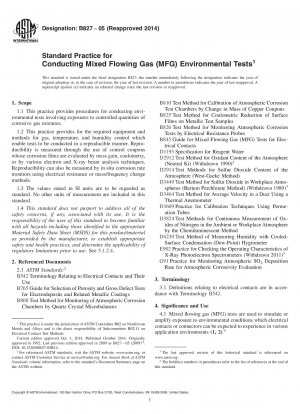ASTM B827-05(2014)
Standard Practice for Conducting Mixed Flowing Gas &40;MFG&41; Environmental Tests
- Standard No.
- ASTM B827-05(2014)
- Release Date
- 2005
- Published By
- American Society for Testing and Materials (ASTM)
- Status
- Replace By
- ASTM B827-05(2020)
- Latest
- ASTM B827-05(2020)
- Scope
4.1 Mixed flowing gas (MFG) tests are used to simulate or amplify exposure to environmental conditions which electrical contacts or connectors can be expected to experience in various application environments (1, 2).4
4.2 Test samples which have been exposed to MFG tests have ranged from bare metal surfaces, to electrical connectors, and to complete assemblies.
4.3 The specific test conditions are usually chosen so as to simulate, in the test laboratory, the effects of certain representative field environments or environmental severity levels on standard metallic surfaces, such as copper and silver coupons or porous gold platings (1, 2).
4.4 Because MFG tests are simulations, both the test conditions and the degradation reactions (chemical reaction rate, composition of reaction products, etc.) may not always resemble those found in the service environment of the product being tested in the MFG test. A guide to the selection of simulation conditions suitable for a variety of environments is found in Guide B845.
4.5 The MFG exposures are generally used in conjunction with procedures which evaluate contact or connector electrical performance such as measurement of electrical contact resistance before and after MFG exposure.
4.6 The MFG tests are useful for connector systems whose contact surfaces are plated or clad with gold or other precious metal finishes. For such surfaces, environmentally produced failures are often due to high resistance or intermittences caused by the formation of insulating contamination in the contact region. This contamination, in the form of films and hard particles, is generally the result of pore corrosion and corrosion product migration or tarnish creepage from pores in the precious metal coating and from unplated base metal boundaries, if present.
4.7 The MFG exposures can be used to evaluate novel electrical contact metallization for susceptibility to degradation due to environmental exposure to the test corrosive gases.
4.8 The MFG exposures can be used to evaluate the shielding capability of connector housings which may act as a barrier to the ingress of corrosive gases.
4.9 The MFG exposures can be used to evaluate the susceptibility of other connector materials such as plastic housings to degradation from the test corrosive gases.
4.10 The MFG tests are not normally used as porosity tests. For a guide to porosity testing, see Guide B765.
4.11 The MFG tests are generally not applicable......
ASTM B827-05(2014) Referenced Document
- ASTM B542 Standard Terminology Relating to Electrical Contacts and Their Use
- ASTM B765 Standard Guide for Selection of Porosity Tests for Electrodeposits and Related Metallic Coatings
- ASTM B808 Standard Test Method for Monitoring of Atmospheric Corrosion Chambers by Quartz Crystal Microbalances
- ASTM B810 Standard Test Method for Calibration of Atmospheric Corrosion Test Chambers by Change in Mass of Copper Coupons
- ASTM B825 Standard Test Method for Coulometric Reduction of Surface Films on Metallic Test Samples
- ASTM B826 Standard Test Method for Monitoring Atmospheric Corrosion Tests by Electrical Resistance Probes
- ASTM B845 Standard Guide for Mixed Flowing Gas (MFG) Tests for Electrical Contacts
- ASTM D1193 Standard Specification for Reagent Water
- ASTM D2914 Standard Test Methods for Sulfur Dioxide Content of the Atmosphere (West-Gaeke Method)
- ASTM D3449 Method of Test for Sulfur Dioxide in Workplace Atmospheres (Barium Perchlorate Method)
- ASTM D3464 Standard Test Method for Average Velocity in a Duct Using a Thermal Anemometer
- ASTM D3609 Standard Practice for Calibration Techniques Using Permeation Tubes
- ASTM D3824 Standard Test Methods for Continuous Measurement of Oxides of Nitrogen in the Ambient or Workplace Atmosphere by the Chemiluminescent Method
- ASTM D4230 Standard Test Method of Measuring Humidity with Cooled-Surface Condensation (Dew-Point) Hygrometer
- ASTM E902 Standard Practice for Checking the Operating Characteristics of X-Ray Photoelectron Spectrometers
- ASTM G91 Standard Practice for Monitoring Atmospheric SO
2 Using the Sulfation Plate Technique
ASTM B827-05(2014) history
- 2020 ASTM B827-05(2020) Standard Practice for Conducting Mixed Flowing Gas (MFG) Environmental Tests
- 2005 ASTM B827-05(2014) Standard Practice for Conducting Mixed Flowing Gas &40;MFG&41; Environmental Tests
- 2009 ASTM B827-05(2009)e2 Standard Practice for Conducting Mixed Flowing Gas (MFG) Environmental Tests
- 2005 ASTM B827-05(2009)e1 Standard Practice for Conducting Mixed Flowing Gas (MFG) Environmental Tests
- 2005 ASTM B827-05 Standard Practice for Conducting Mixed Flowing Gas (MFG) Environmental Tests
- 1997 ASTM B827-97(2003) Standard Practice for Conducting Mixed Flowing Gas (MFG) Environmental Tests
- 1997 ASTM B827-97 Standard Practice for Conducting Mixed Flowing Gas (MFG) Environmental Tests

Copyright ©2024 All Rights Reserved